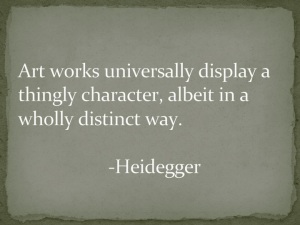Defining Art, Letter III: Enter Heidegger
[to read Letter II, click here]
Dear Alex,
I was reading Heidegger the other day. A little light beach reading that I did not quite get to over the summer. So there was Heidegger, sitting on my lap next to my Sunday crossword puzzle, and it came to me.
Art is a thing.
Not only that, but according to Heidegger, it has thingness and a thingly nature. In “The Work of Art,” he writes:
“Art works universally display a thingly character, albeit in a wholly distinct way. The attempt to interpret this thing-character of the work with the aid of the usual thing-concepts failed — not only because these concepts do not lay hold of the thingly feature, but because, in raising the question of its thingly substructure, we force the work into a preconceived framework by which we obstruct our own access to the work-being of the work.”
I am not sure that he says this as clearly as he might, but there is something afoot in these words, something valuable. If art is a thing, it has its own nature. And if it has its own nature, then there must be something – some thing – out there for us to define. Our problem, however, is that we are trying to use language suited for other things in order to define the art-thing, and that approach does not work.
I love what you wrote in your letter, and your closing words really strike home: “Art gives us privileged moments. It is an experience that stands apart from our every day lives. Because it’s distinct, we need to define it.” Yes, yes, and a thousand times yes. As I read your words and reflect on Heidegger’s thing, I think that we need to find that essence of what is distinct in art. That distinct quality moves us beyond the rules of the game for all other experiences. Art is ineffable as you say, and yet it is also real. A paradox. The paradox takes me to what the Romantics have to say on the subject, that we are trying to comprehend the incomprehensible, express the inexpressible.
Yet I do not want to dodge the question simply by saying it is all just “inexpressible.” So what makes art “distinct”? First, art creates that which did not exist previously. Second, art creation comes from a place separate from other human acts. Third, we receive art (as listener, viewer, reader, etc.) in a way that is also distinct from all other acts.
So where do we go from here?
With a shared respect for distinctness,
Andrew











I don’t think Heidegger said anything as clearly as he might.
But this is what I think he’s up to. For Heidegger any revealing of something, whether through language or some other medium, presupposes that something is concealed. Think of it this way: we cannot focus on something in the foreground of experience and at the same time fully grasp the background of experience. The very idea of a foreground presupposes an indeterminate background. With regard to ordinary objects, we are either fully immersed in our habitual activity with them so the contrast between foreground and background dissolves or we stand back and considered them objectively in which case the foreground becomes our focus and the background is inert. But in neither case do we get the whole in view.
Works of art on Heidegger’s view exist in the vortex of this interplay and reveal the tension between foreground and background. Van Gogh’s shoes reveal their Being as pieces of equipment, with their markings of wear, drudgery, the resistance of the world, but also of successful harvests, the historical path of the farmer. But there are intimations of something else in the painting that cannot be fully expressed as an element of the “world” of the farmer, brief glimpses of something not fully expressed that suggests a different destiny, a fundamental instability of the farmer’s world.
Thus, any account of the system of representation in the painting will be incomplete.
It is not at all clear to me that Heidegger thinks there is something distinctive about works of art. It seems to me its our mode of engagement with an object that makes it a work of art. After all, the three examples he uses–Van Gogh’s painting, a Greek temple, and a poem, are quite different kinds of objects.
Very nicely put. I would agree with all of the observations but one — on whether or not Heidegger thinks there is something distinctive about art. Perhaps this is a difference in semantics between your interpretation and mine.
I do think that Heidegger considers art to “work” on us in its own, unique way, and this effect differs from saying a similar thing in non-aesthetic language. To use your very appropriate example of the shoes in Van Gogh, to paint the shoes differs from saying “the farmer has experienced drudgery” as a reporter might speak of the farmer’s experience. The art work has something intrinsic to it that drives specifically aesthetic responses. However, at the same time as you well point out, those responses also are part of the “work of art”; that is, we also make it an art work with our engagement. So it is a function of both the art work and the work of art on us, what Thomas Wartenberg calls Heidegger’s “holistic account that treats every aspect of art — artist (or ‘creator’ in his terminology), work, and audience (‘preserver’) — as essential to it” (Routledge Companion to Aesthetics, 2nd Ed., p. 149). Yet your final point brings us back to one of the things that, I think, is most helpful in Heidegger. He is one of the few aestheticians who actually gives us a system of thought that works across different art forms (painting, poetry, architecture, etc.), where the writings of so many other thinkers work well perhaps in one area but not as well in another.
Many thanks for your thoughts.
–Andrew Swensen